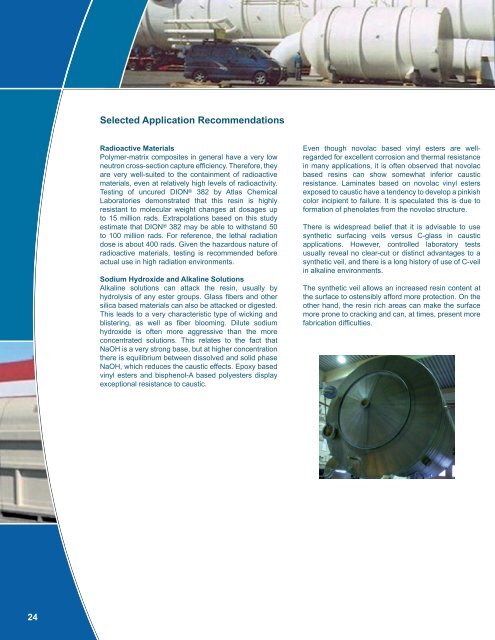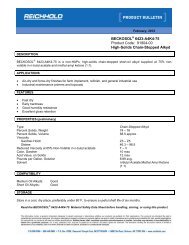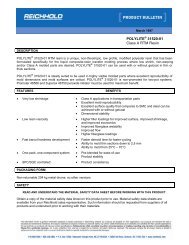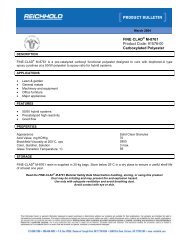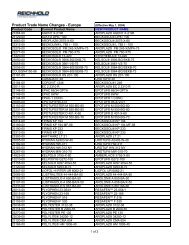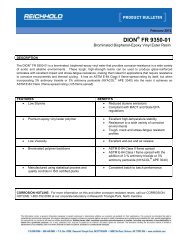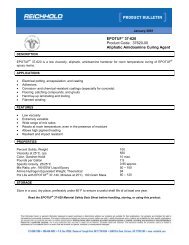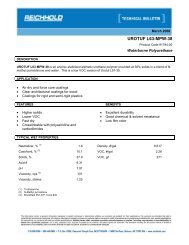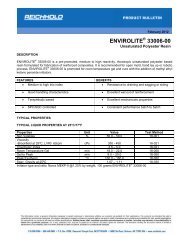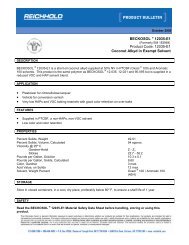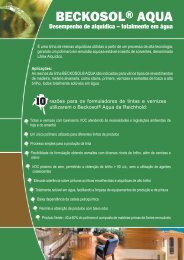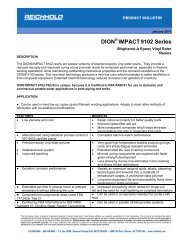CORROSION GUIDE 181108_new table content format ... - Reichhold
CORROSION GUIDE 181108_new table content format ... - Reichhold
CORROSION GUIDE 181108_new table content format ... - Reichhold
You also want an ePaper? Increase the reach of your titles
YUMPU automatically turns print PDFs into web optimized ePapers that Google loves.
Selected Application Recommendations<br />
Radioactive Materials<br />
Polymer-matrix composites in general have a very low<br />
neutron cross-section capture effi ciency. Therefore, they<br />
are very well-suited to the containment of radioactive<br />
materials, even at relatively high levels of radioactivity.<br />
Testing of uncured DION ® 382 by Atlas Chemical<br />
Laboratories demonstrated that this resin is highly<br />
resistant to molecular weight changes at dosages up<br />
to 15 million rads. Extrapolations based on this study<br />
estimate that DION ® 382 may be able to withstand 50<br />
to 100 million rads. For reference, the lethal radiation<br />
dose is about 400 rads. Given the hazardous nature of<br />
radioactive materials, testing is recommended before<br />
actual use in high radiation environments.<br />
Sodium Hydroxide and Alkaline Solutions<br />
Alkaline solutions can attack the resin, usually by<br />
hydrolysis of any ester groups. Glass fi bers and other<br />
silica based materials can also be attacked or digested.<br />
This leads to a very characteristic type of wicking and<br />
blistering, as well as fi ber blooming. Dilute sodium<br />
hydroxide is often more aggressive than the more<br />
concentrated solutions. This relates to the fact that<br />
NaOH is a very strong base, but at higher concentration<br />
there is equilibrium between dissolved and solid phase<br />
NaOH, which reduces the caustic effects. Epoxy based<br />
vinyl esters and bisphenol-A based polyesters display<br />
exceptional resistance to caustic.<br />
Even though novolac based vinyl esters are wellregarded<br />
for excellent corrosion and thermal resistance<br />
in many applications, it is often observed that novolac<br />
based resins can show somewhat inferior caustic<br />
resistance. Laminates based on novolac vinyl esters<br />
exposed to caustic have a tendency to develop a pinkish<br />
color incipient to failure. It is speculated this is due to<br />
<strong>format</strong>ion of phenolates from the novolac structure.<br />
There is widespread belief that it is advisable to use<br />
synthetic surfacing veils versus C-glass in caustic<br />
applications. However, controlled laboratory tests<br />
usually reveal no clear-cut or distinct advantages to a<br />
synthetic veil, and there is a long history of use of C-veil<br />
in alkaline environments.<br />
The synthetic veil allows an increased resin <strong>content</strong> at<br />
the surface to ostensibly afford more protection. On the<br />
other hand, the resin rich areas can make the surface<br />
more prone to cracking and can, at times, present more<br />
fabrication diffi culties.<br />
24


